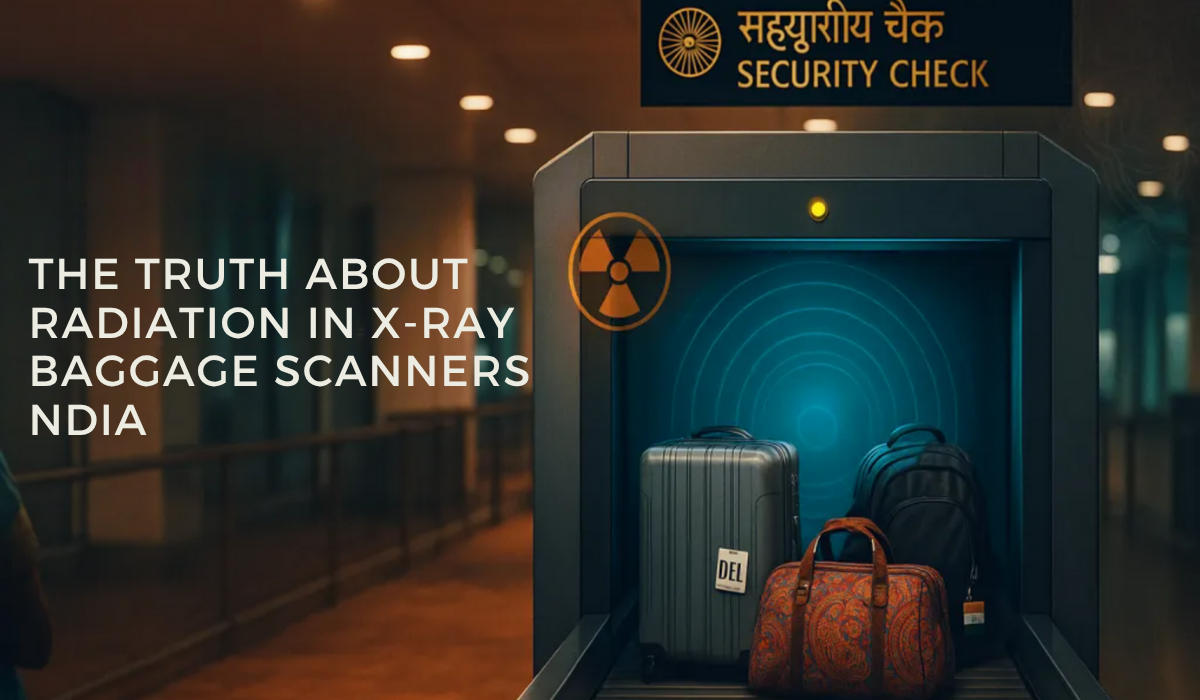Introduction: Decoding the Mystery
When you walk into an Indian airport, a railway station, or a busy government building, you’re sure to see the X-ray baggage scanner at work. These both fascinate and worry many travelers—what exactly is happening to your valuables, clothes, and snacks as they pass through those glowing machines? Most importantly, is there any danger from the radiation in X-ray baggage scanners? Let’s unravel the truth behind Radiation in X-ray Baggage Scanners with facts, common sense, and a close look at how India keeps you safe.
How Do Radiation in X-ray Baggage Scanners Work?
The principle behind an X-ray baggage scanner is simple yet impressive. Each scanner emits a controlled beam of X-rays. As your bag travels through on a conveyor belt, the X-ray passes through it. Denser materials like metal absorb more rays, while less dense materials let more rays pass. The process, guided by radiation in X-ray baggage scanners, allows the detector to turn this into an accurate image for security teams. Security staff can quickly spot any dangerous or prohibited items, thanks to the surprising accuracy of radiation in X-ray baggage scanners technology.
What About Radiation in X-ray Baggage Scanners Exposure?
Many are concerned: “Is it safe?” The answer is, yes, it’s quite safe. In India and globally, radiation in X-ray baggage scanners is designed to be minimal. These levels are far below the safety limits set by regulatory bodies, making it safe for both staff and travelers. In fact, radiation in X-ray baggage scanners is so low that you likely receive more natural background radiation spending a day outdoors than your suitcase does going through a baggage scanner.
Regulatory agencies, such as the Atomic Energy Regulatory Board (AERB) in India, carefully approve and monitor radiation in X-ray baggage scanners for mechanical, electrical, and radiation safety. Every installation must meet strict guidelines and only devices with safe radiation in X-ray baggage scanners standards are installed in Indian airports, stations, and other sensitive areas..
Where Are X-ray Baggage Scanners Used in India?
X-ray baggage scanners are now a common sight in:
- Airports (across all major Indian cities)
- Railway stations and metro stations
- Government buildings and courts
- Malls, hotels, and major public events
India has stepped up the deployment of these scanners after global increases in security threats. Indian manufacturers are now leading providers of advanced X-ray baggage scanner technology, meeting the unique needs of busy Indian environments.
Did You Know? Surprising Facts About Radiation and Safety
What Makes Indian Standards Unique?
- Strict Monitoring: Indian authorities test and approve every X-ray baggage scanner. The Atomic Energy Regulatory Board (AERB) ensures devices meet global safety standards before they reach any airport or public facility.
- Regular Maintenance: Routine tests ensure that radiation leakage is well below allowed limits, safeguarding both workers and the public.
- Touch-Free Screening: Modern scanners now use advanced, AI-powered image analysis, making bag checks more accurate, faster, and sometimes, even touch-free.
Surprising Myths vs. Reality
Future Trends for X-ray Baggage Scanners in India
India is not just following global trends but setting new standards. The X-ray baggage scanner market in India is now seeing:
- Adoption of 3D computed tomography (CT) scanners: This technology brings hospital-grade clarity to baggage screening, reducing both false alarms and wait times.
- Integration of artificial intelligence: AI now helps security staff identify threats with surprising accuracy, leading to fewer human errors and smoother operations.
- Faster, more compact machines: Stations and airports are installing scanners that process more bags in less time, keeping busy Indian queues moving swiftly.
The Role of Regulations—A Safety Net
India’s strict regulatory environment means only approved X-ray baggage scanner models are allowed. To do this, the AERB checks for:
- Approved levels of radiation
- Effective shielding to avoid leakage
- Automatic shutdown features if a malfunction occurs
On top of that, staff operating these machines complete rigorous training to make sure operations are handled professionally and safely.
X-ray Baggage Scanner—A Surprising Ally for Security
Next time you pass your suitcase, backpack, or briefcase through the glowing tunnel of an X-ray baggage scanner in India, remember—you’re part of a security system that’s not just efficient, but also safe. Scanners keep millions safe daily, help curb crime, and protect public spaces, all while making minimal impact with radiation that is strictly regulated and surprisingly low.
Final Thoughts: Safety First
The X-ray baggage scanner is today’s unsung hero, protecting India’s travelers, employees, and infrastructure with reliability, speed, and safety. The surprising truth? There’s no need to worry about the radiation from baggage scanners in India. Whether you’re flying, commuting, or just visiting a government building, you can travel assured—your bag is safe, your belongings are secure, and the technology keeping you safe is one of the smartest in the world.

